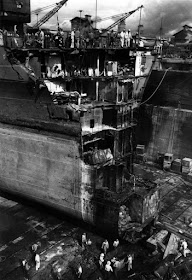Pacific Historic Parks provides this short book at the Pearl Harbor Visitor Center, overlooking USS Arizona and "Battleship Row" next to Ford Island in Pearl Harbor.
 The cover reads: "A Native Son of Hawaii's memories of the War in the Pacific while on duty during the surprise attack at Pearl Harbor and while serving on the battleship USS Washington in the Pacific Theater."
The cover reads: "A Native Son of Hawaii's memories of the War in the Pacific while on duty during the surprise attack at Pearl Harbor and while serving on the battleship USS Washington in the Pacific Theater."This is his wartime diary aboard USS Washington (BB-56) as well as his insights and reflections as a volunteer at the Visitor Center, where his message to visitors is: "Freedom is not free."
This enjoyable little book, published in 2014, starts with Rodrigues's recollections as a young boy growing up in Hawaii.
Al was born on the island of Kauai on February 7, 1920. His full name: Alfred Benjamin Kameeiamoku Rodrigues. Al's mother was Hawaiian. She died when Al was only 8, "and I felt like I wanted to die also. I loved her so much." Al's father was of Portuguese descent. He experienced some prejudice growing up in mixed-race family on Kauai.
 |
| Kapaa Kauai in 1924, looking away from Lihue and toward "Sleeping Giant" mountain range. |
"I played football, volleyball, basketball and baseball and was also on the swimming team so kept busy. The only wrong thing I did was take up smoking, so there went my caddy money. I finally quit smoking when I retired from the Navy."Rodrigues joined the Navy with an ambition to be an engineering, but under the guidance of Navy Chief George Maile, a fellow Sailor from Hawaii, he chose instead to become a storekeeper. "It made a difference on the rest of my career in the Navy."
 |
| Gunners aboard USS Ward (DD-139). |
"On December 7, 1941, I had the four-to-eight watch; and the officer of the deck, who was a quartermaster second class, told me that they had received a message at 3:30 a.m. that our destroyer the USS Ward (DD-139) had dropped depth charges on an unidentified submarine and sunk it."Al had just put his breakfast tray down when he could hear explosions "in the shipyard area." He and his buddies assumed it was dredging work until he heard the General Alarm. They all ran to the armory where they were issued .30 caliber rifles or .45 pistols. Not much help against the incoming enemy planes, red rising suns on the bottom of their wings.
"They were flying low enough that you could see the pilots' faces. We heard yells to shoot the pilot as they had open cockpits. Hell, it was hard enough to shoot the airplane, much less the pilot. With a rifle of 1941 vintage, you could only shoot one bullet at a time then cock the rifle before shooting the next shot, and by then the plane was out of reach."
 |
| Naval Supply Center at Pearl Harbor in the 1940s. |
This book is filled with tweet-size stories about characters like Sake-Mac, the Chief Commissary man; an unnamed bunkmate accused of murder in New York; and C.B. Wilson, who helped Al sneak out at night for a luau.
 |
| USS Washington (BB-56) in the Shipyard after a collision with USS Indiana (BB-58) in 1944. |
Al gives us a feel for day-to-day life during wartime aboard USS Washington and how the enemy was viewed by Sailors and the nation at the time. The cover of his diary was inscribed with some of the locations he visited, including Palau, Gilberts, Nauru, Marianas and Marshall Islands, where his ship's bow was crushed in a collision with USS Indiana (BB-58).
We see how close Al was to his sister, Nani.
Al remembers fondly some time he finagled in New York City, which welcomed service members who had served in the war. After the war he returned to Hawaii.
"The City and County of Honolulu had an ad asking for men to join the police force and I applied. The first thing they did was make me get on a scale and I weighed 149 pounds. The sergeant told me to go home, eat some bananas and come back tomorrow as the minimum weight was 150 pounds. Did that; I ate a few and the next day I was accepted for the next recruit training as I met the correct weight."
 |
| Al Rodrigues's diary. |
He married "the cutest local Japanese girl," Ruth, and raised a family – three sons, Kammy, Jay and Ronald. Ronald was born in Yokosuka, Japan when Al was stationed at Naval Supply Depot there. "In 1960, sometime while stationed at the Naval Ammunition Depot in Lualualei, Oahu, Ruth and I split. We had differences and she eventually married a guy named Pete, who was a Navy friend of mine. It sure is funny how some things just work out for the best – for all concerned."
 |
| Pearl Harbor Survivors Sterling Cale and Al Rodrigues meet young visitors in 2009. |
Today, Al Rodrigues volunteers at the Pearl Harbor Visitor Center where he meets people "from many foreign countries and every state in the Union."
"In closing, I want to remind people that we should honor the memories of my generation so that we can pass to future generations the stories of what those brave, heroic men and women of World war II did to preserve our freedom. Freedom is not free."Thank you to Agnes Tauyan, Director of Public Affairs for Navy Region Hawaii, for recommending this book for a Navy Reads review.
No comments:
Post a Comment